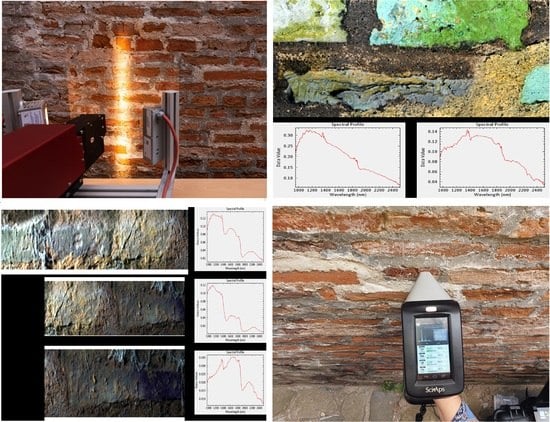Multi-Analytical Investigations of the Medieval Turkish Bath from Golești Open Air Museum
Abstract
:1. Introduction
2. Materials and Methods
3. Results and Discussions
3.1. HSI Analysis
3.2. LIBS
3.3. Classification
4. Conclusions
Author Contributions
Funding
Data Availability Statement
Conflicts of Interest
References
- Fernandes, F.M.; Lourenço, P.B.; Castro, F. Ancient Clay Bricks: Manufacture and Properties. In Materials, Technologies and Practice in Historic Heritage Structures; Springer: Berlin/Heidelberg, Germany, 2010. [Google Scholar] [CrossRef] [Green Version]
- Teodoru, R. Curți întărite târzii. Stud. Și Cercet. Istor. Artei 1963, X, 343. [Google Scholar]
- Din Alep, P. Jurnal de călătorie în Moldova și Valahia; Ioana Feodorov editions; Romanian Academy Publishing House and Istros Publishing House: Bucharest, Romania, 2014. [Google Scholar]
- Potra, G. Din Bucureștii de Altădată; Scientific and Encyclopedic Publishing House: Bucharest, Romania, 1981. [Google Scholar]
- Galbács, G. A critical review of recent progress in analytical laser-induced breakdown spectroscopy. Anal. Bioanal. Chem. 2015, 407, 7537–7562. [Google Scholar] [CrossRef] [PubMed]
- Carmona-Quiroga, P.M.; Martínez-Ramírez, S.; Sánchez-Cortés, S.; Oujja, M.; Castillejo, M.; Blanco-Varela, M.T. Effectiveness of antigraffiti treatments in connection with penetration depth determined by different techniques. J. Cult. Herit. 2010, 11, 297–303. [Google Scholar] [CrossRef]
- Palleschi, V. (Ed.) Chemometrics and Numerical Methods in LIBS. Wiley: Hoboken, NJ, USA, 2022. [Google Scholar]
- Zahiri, Z.; Laefer, D.F.; Kurz, T.; Buckley, S.; Gowen, A. A comparison of ground-based hyperspectral imaging and red-edge multispectral imaging for façade material classification. Autom. Constr. 2022, 136, 104164. [Google Scholar] [CrossRef]
- Popescu, M.; Iliescu, C. Golești; Meridiane Publishing House: Bucharest, Romania, 1966. [Google Scholar]
- Pagnotta, S.; Lezzerini, M.; Campanella, B.; Gallello, G.; Grifoni, E.; Legnaioli, S.; Lorenzetti, G.; Poggialini, F.; Raneri, S.; Safi, A.; et al. Fast quantitative elemental mapping of highly inhomogeneous materials by micro-Laser-Induced Breakdown Spectroscopy. Spectrochim. Acta Part B At. Spectrosc. 2018, 146, 9–15. [Google Scholar] [CrossRef] [Green Version]
- Živković, S.; Botto, A.; Campanella, B.; Lezzerini, M.; Momčilović, M.; Pagnotta, S.; Palleschi, V.; Poggialini, F.; Legnaioli, S. Laser-Induced Breakdown Spectroscopy elemental mapping of the construction material from the Smederevo Fortress (Republic of Serbia). Spectrochim. Acta Part B At. Spectrosc. 2021, 181, 106219. [Google Scholar] [CrossRef]
- Dontu, S.; Miclos, S.; Savastru, D.; Tautan, M. Combined spectral-domain optical coherence tomography and hyperspectral imaging applied for tissue analysis: Preliminary results. Appl. Surf. Sci. 2017, 417, 119–123. [Google Scholar] [CrossRef]
- Cheng, J.H.; Nicolai, B.; Sun, D.W. Hyperspectral imaging with multivariate analysis for technological parameters prediction and classification of muscle foods: A review. Meat Sci. 2017, 123, 182–191. [Google Scholar] [CrossRef]
- Ravikanth, L.; Jayas, D.S.; White, N.D.G.; Fields, P.G.; Sun, D.W. Extraction of Spectral Information from Hyperspectral Data and Application of Hyperspectral Imaging for Food and Agricultural Products. Food Bioprocess Technol. 2017, 10, 1–33. [Google Scholar] [CrossRef]
- Spizzichino, V.; Fantoni, R. Laser Induced Breakdown Spectroscopy in archeometry: A review of its application and future perspectives. Spectrochim. Acta Part B At. Spectrosc. 2014, 99, 201–209. [Google Scholar] [CrossRef]
- Gaudiuso, R.; Dell’Aglio, M.; de Pascale, O.; Senesi, G.S.; de Giacomo, A. Laser induced breakdown spectroscopy for elemental analysis in environmental, cultural heritage and space applications: A review of methods and results. Sensors 2010, 10, 7434–7468. [Google Scholar] [CrossRef] [PubMed] [Green Version]
- Hahn, D.W.; Omenetto, N. Laser-induced breakdown spectroscopy (LIBS), part II: Review of instrumental and methodological approaches to material analysis and applications to different fields. Appl. Spectrosc. 2012, 66, 347–419. [Google Scholar] [CrossRef]
- Botto, A.; Campanella, B.; Legnaioli, S.; Lezzerini, M.; Lorenzetti, G.; Pagnotta, S.; Poggialini, F.; Palleschi, V. Applications of laser-induced breakdown spectroscopy in cultural heritage and archaeology: A critical review. J. Anal. At. Spectrom. 2019, 34, 81–103. [Google Scholar] [CrossRef]
- Atanassova, V.; Ghervase, L.; Cortea, I.M.; Mihailov, V.; Tankova, V.; Nikolov, V. Multi-analytical approach for characterization of archaeological pottery excavated in the Early-Neolithic settlement of Chavdar, Bulgaria. Spectrosc. Lett. 2021, 54, 549–559. [Google Scholar] [CrossRef]
- Pacher, U.; Dinu, M.; Nagy, T.O.; Radvan, R.; Kautek, W. Multiple wavelength stratigraphy by laser-induced breakdown spectroscopy of Ni-Co alloy coatings on steel. Spectrochim. Acta Part B At. Spectrosc. 2018, 146, 36–40. [Google Scholar] [CrossRef]
- Ghervase, L.; Dinu, M.; Borș, C.; Angheluță, L.M.; Rădvan, R.; Cortea, I.M. Investigation on Metal Adornments From Ancient Eastern Europe. Front. Mater. 2020, 7, 600913. [Google Scholar] [CrossRef]
- Cortea, I.M.; Ratoiu, L.; Ghervase, L.; Țentea, O.; Dinu, M. Investigation of ancient wall painting fragments discovered in the roman baths from alburnus maior by complementary non-destructive techniques. Appl. Sci. 2021, 11, 10049. [Google Scholar] [CrossRef]
- Cucci, C.; Picollo, M.; Chiarantini, L.; Uda, G.; Fiori, L.; De Nigris, B.; Osanna, M. Remote-sensing hyperspectral imaging for applications in archaeological areas: Non-invasive investigations on wall paintings and on mural inscriptions in the Pompeii site. Microchem. J. 2020, 158, 105082. [Google Scholar] [CrossRef]
- Miliani, C.; Rosi, F.; Daveri, A.; Brunetti, B.G. Reflection infrared spectroscopy for the non-invasive in situ study of artists’ pigments. Appl. Phys. A Mater. Sci. Process. 2012, 106, 295–307. [Google Scholar] [CrossRef]
- Sánchez, J.; Quirós, E. Semiautomatic detection and classification of materials in historic buildings with low-cost photogrammetric equipment. J. Cult. Herit. 2017, 25, 21–30. [Google Scholar] [CrossRef]
- Canty, M.J. Image Analysis, Classification and Change Detection in Remote Sensing: With Algorithms for ENVI/IDL and Python, 3rd ed.; CRC Press: Boca Raton, FL, USA, 2014; ISBN 9781466570382. [Google Scholar]
- Bai, D.; Messinger, D.W.; Howell, D. A hyperspectral imaging spectral unmixing and classification approach to pigment mapping in the Gough & Selden Maps. J. Am. Inst. Conserv. 2019, 58, 69–89. [Google Scholar] [CrossRef]
- Allios, D.; Guermeur, N.; Cocoual, A.; Linderholm, J.; Sciuto, C.; Geladi, P.; Gobrecht, A.; Bendoula, R.; Moura, D.; Jay, S.; et al. Near Infrared Spectra and Hyperspectral Imaging of Medieval Fortress Walls in Carcassonne: A Comprehensive Interdisciplinary Field Study. NIR News 2016, 27, 16–20. [Google Scholar] [CrossRef]
- Bernstein, L.S. Quick atmospheric correction code: Algorithm description and recent upgrades. Opt. Eng. 2012, 51, 111719. [Google Scholar] [CrossRef]
- Capedri, S.; Venturelli, G. Provenance determination of trachyctic lavas, employed as blocks in the Romanesque cathedral of Modena (Northern Italy), using magnetic susceptibility, and petrographic and chemical parameters. J. Cult. Herit. 2005, 6, 7–19. [Google Scholar] [CrossRef]
- Gomoiu, R.I.; Cojoc, R.; Ruginescu, S.; Neagu, M.; Enache, G.; Maria, M.; Dumbrăvician, I.; Olteanu, R.; Rădvan, L.; Ratoiu, V.; et al. Brackish and Hypersaline Lakes as Potential Reservoir for Enzymes Involved in Decomposition of Organic Materials on Frescoes. Fermentation 2022, 8, 462. [Google Scholar] [CrossRef]
- Angheluta, L.; Striber, J.; Radvan, R.; Gomoiu, I.; Dragomir, V. Non-contact and non-invasive photonic device for qualitative fungal contamination control. Math. Comput. Biol. Chem. 2008, 4, 147–156. [Google Scholar]
- Angheluţă, L.M.; Chiroşca, A. Physical degradation detection on artwork surface polychromies using deep learning models. Rom. Rep. Phys. 2020, 72, 805. [Google Scholar]

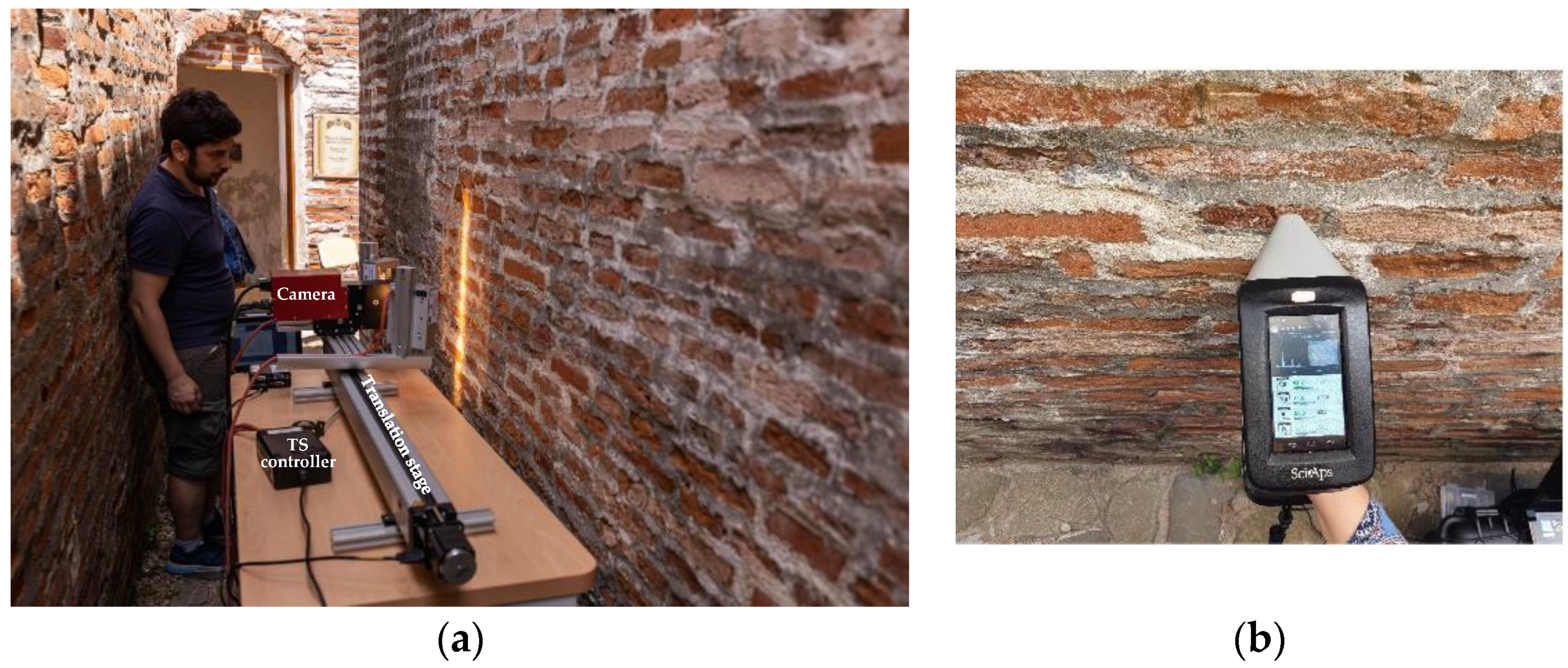
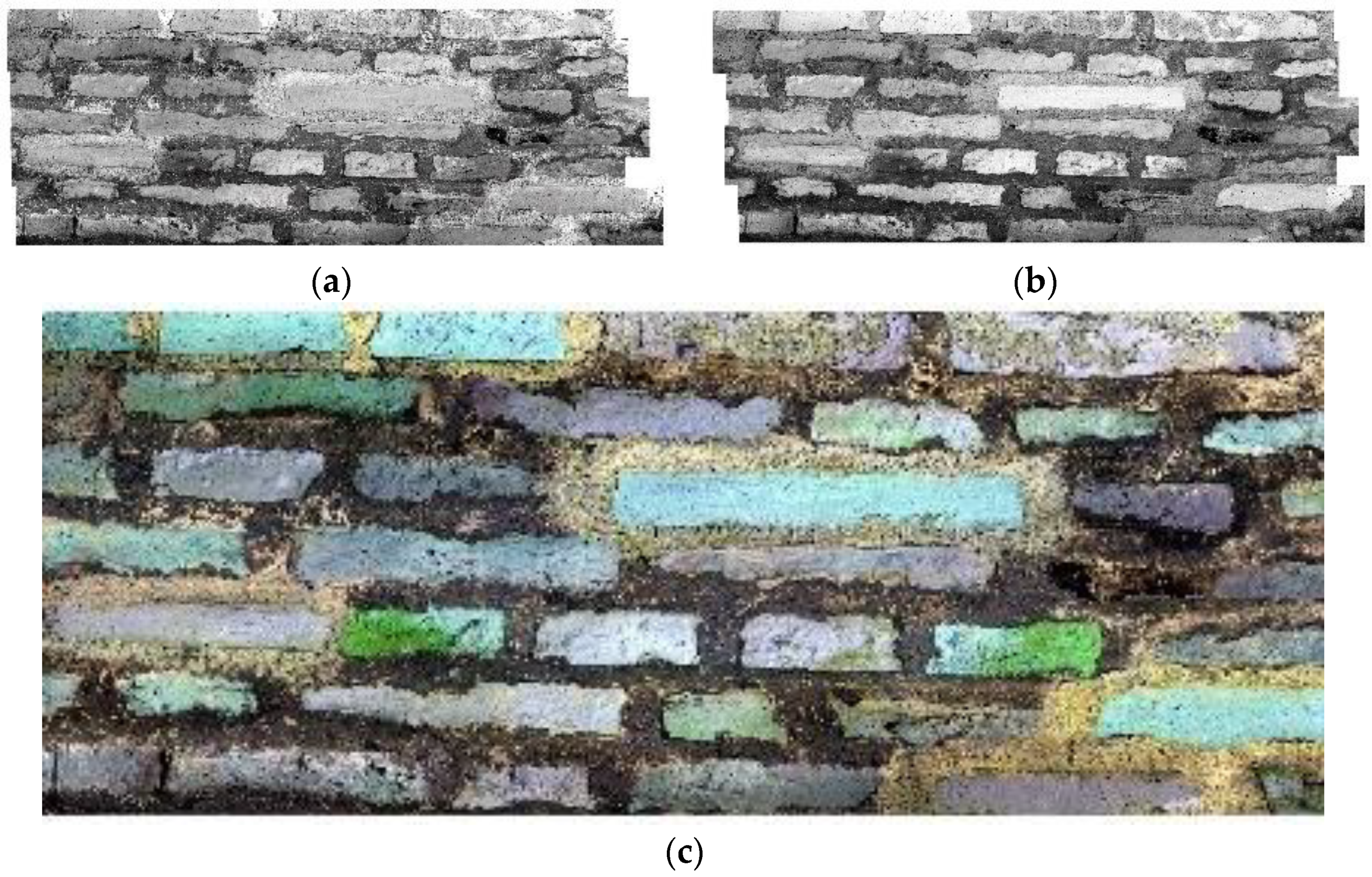

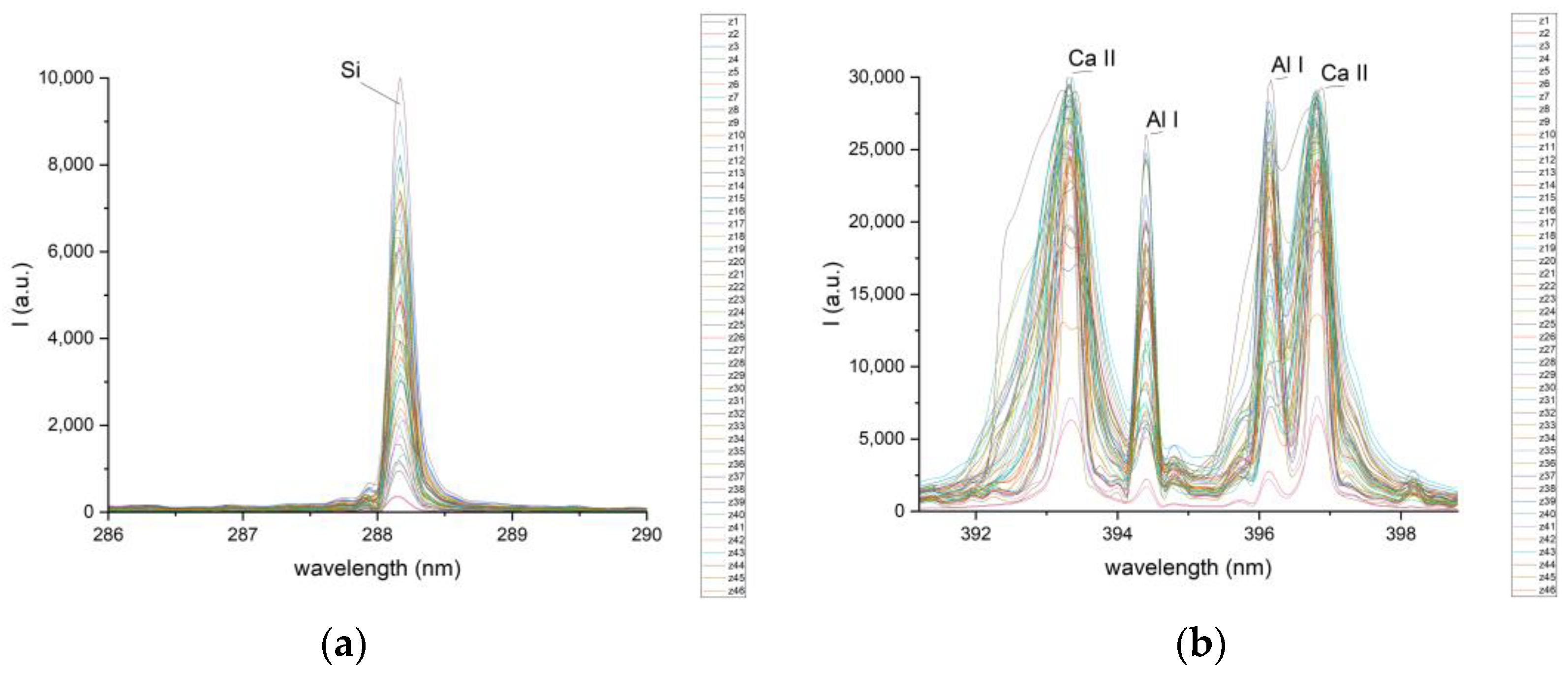
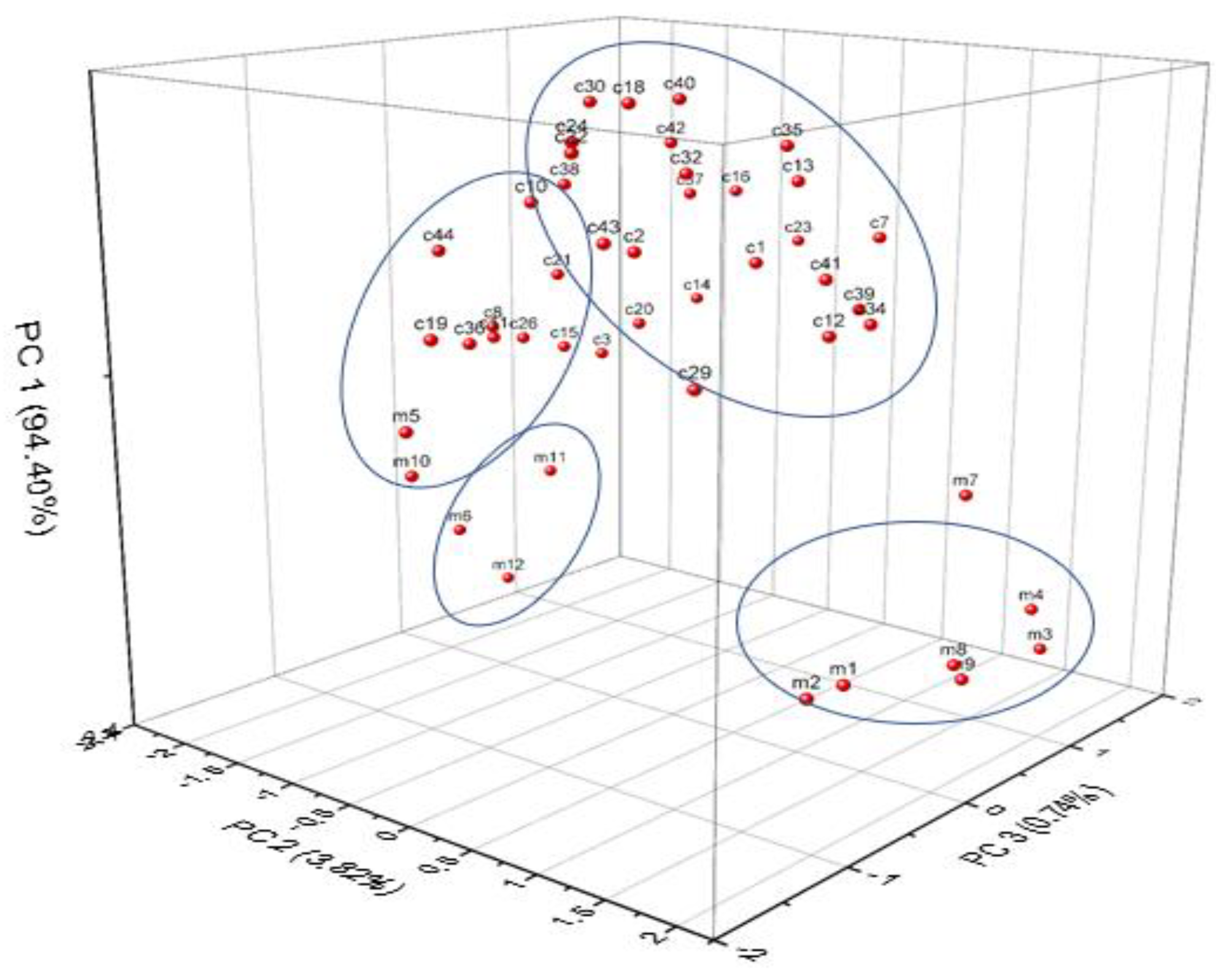


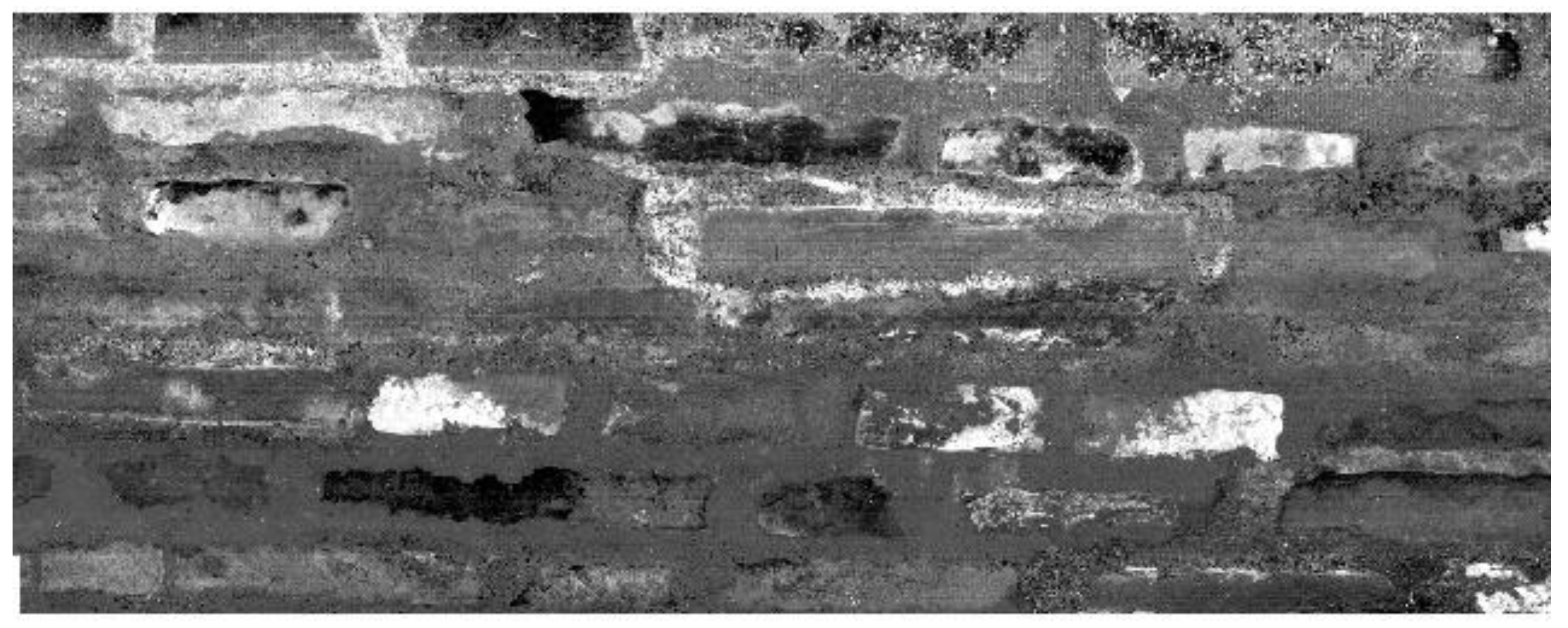
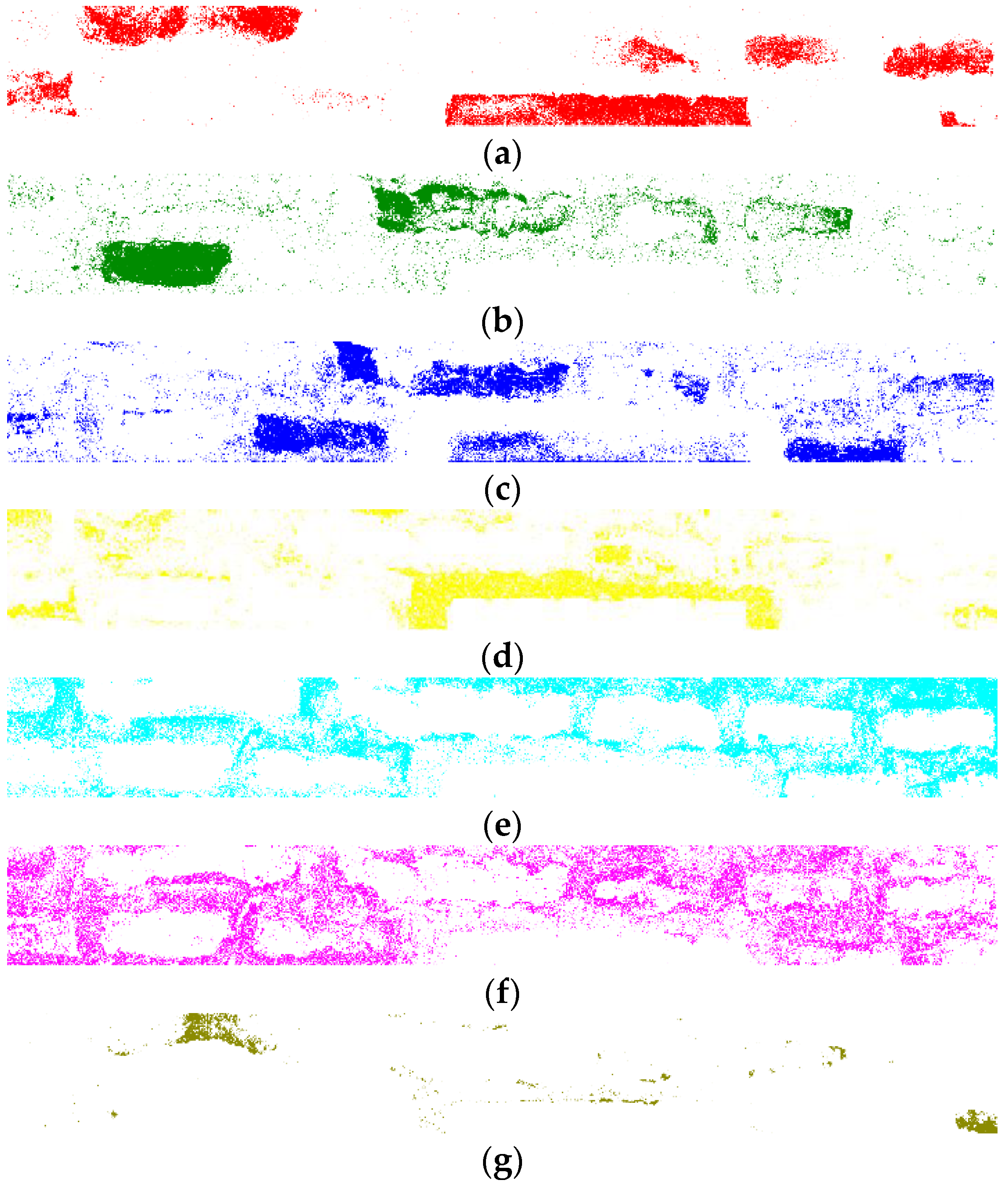
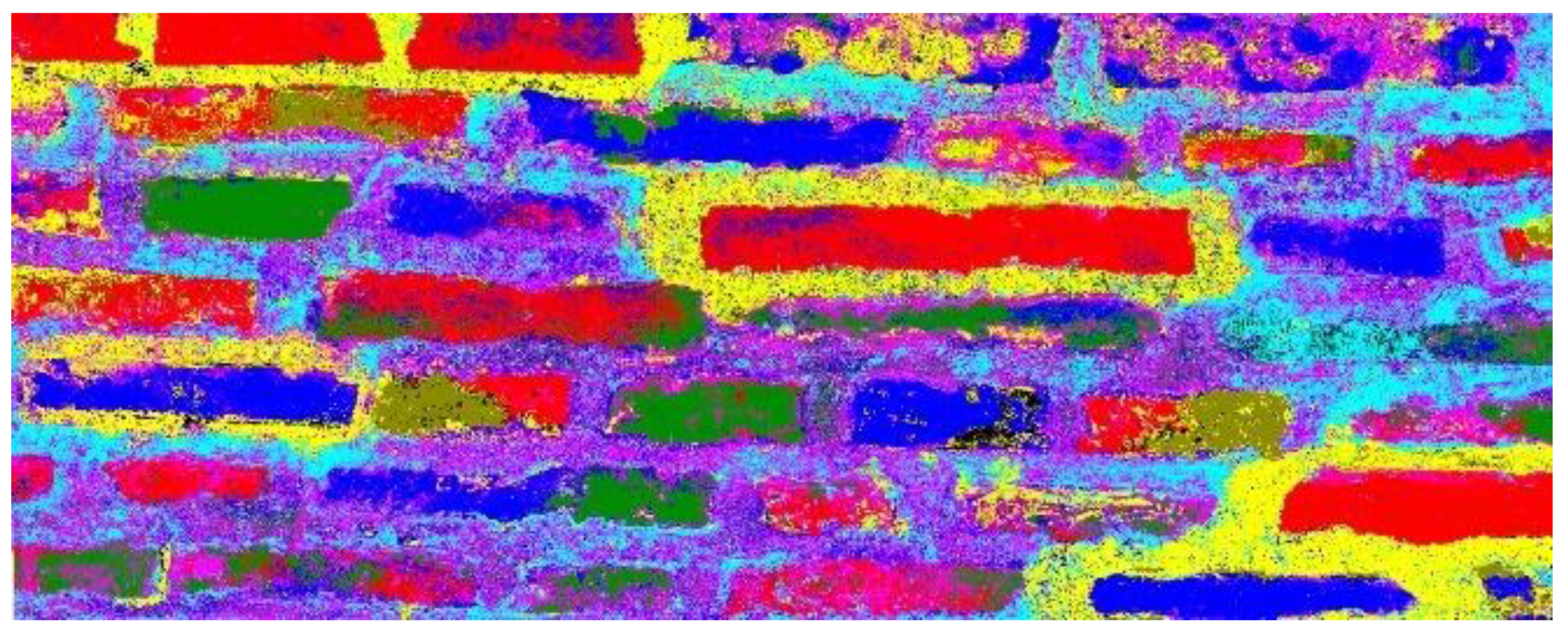

| Type of Material | Main Chemical Elements Identified by LIBS Averaged Data |
|---|---|
| Bricks | Si, Al, Mg, Fe, K, Na, Ca, O, C, Ti |
| Reddish mortar areas | Ca, Si, Sr, Al, Na, Mg, K, C, Fe, O, Ti |
| Grey mortar areas | Ca, Si, Na, Al, K, C, Sr, O |
Disclaimer/Publisher’s Note: The statements, opinions and data contained in all publications are solely those of the individual author(s) and contributor(s) and not of MDPI and/or the editor(s). MDPI and/or the editor(s) disclaim responsibility for any injury to people or property resulting from any ideas, methods, instructions or products referred to in the content. |
© 2023 by the authors. Licensee MDPI, Basel, Switzerland. This article is an open access article distributed under the terms and conditions of the Creative Commons Attribution (CC BY) license (https://creativecommons.org/licenses/by/4.0/).
Share and Cite
Dinu, M.; Ratoiu, L.C.; Călin, C.; Călin, G. Multi-Analytical Investigations of the Medieval Turkish Bath from Golești Open Air Museum. Buildings 2023, 13, 321. https://doi.org/10.3390/buildings13020321
Dinu M, Ratoiu LC, Călin C, Călin G. Multi-Analytical Investigations of the Medieval Turkish Bath from Golești Open Air Museum. Buildings. 2023; 13(2):321. https://doi.org/10.3390/buildings13020321
Chicago/Turabian StyleDinu, Monica, Lucian Cristian Ratoiu, Camelia Călin, and Gerard Călin. 2023. "Multi-Analytical Investigations of the Medieval Turkish Bath from Golești Open Air Museum" Buildings 13, no. 2: 321. https://doi.org/10.3390/buildings13020321






